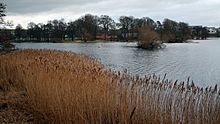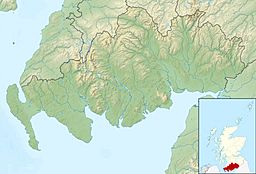Carlingwark Loch facts for kids
Quick facts for kids Carlingwark Loch |
|
|---|---|

Carlingwark Loch - geograph.org.uk - 1180333
|
|
| Coordinates | 54°55′48″N 3°56′1″W / 54.93000°N 3.93361°W |
| Type | freshwater loch |
| Primary inflows | Gelston burn |
| Primary outflows | Carlingwark Lane |
| Catchment area | 13.05 km2 (5.04 sq mi) |
| Basin countries | Scotland |
| Max. length | .075 mi (0.121 km) |
| Max. width | 0.33 mi (0.53 km) |
| Average depth | 7 ft (2.1 m) |
| Max. depth | 17 ft (5.2 m) |
| Water volume | 3,100,000 cu ft (88,000 m3) |
| Surface elevation | 143 ft (44 m) |
Carlingwark Loch is a small, freshwater loch (which is the Scottish word for a lake). It is located in Dumfries and Galloway, Scotland, just south of the town of Castle Douglas. The loch is shaped like a rectangle, stretching from north to south.
The name of the loch comes from old words. Caer is a Scots Gaelic word meaning "fort." Wark is an old Scots language word for "work." This name makes sense because there are four small, man-made islands in the loch. These islands show signs that people once built forts or lived there. One of these islands, Ash Island, might even be a crannog, which is an ancient island home.
Contents
History and Discoveries
People have found many interesting things in Carlingwark Loch over the years. These discoveries show that the area has been important for a very long time.
Ancient Finds
Archaeologists have found several old items in the loch. These include a bronze cauldron, a sword, and a pan. They also found two dugout canoes. These items give us clues about the people who lived around the loch in the past.
Carlingwark Lane Canal
A canal called Carlingwark Lane Canal was built in 1765. This canal was about 1.5 mi (2.4 km) long. It connected Carlingwark Loch to the River Dee.
The canal was used by flat-bottomed boats. These boats carried a material called shell-marl to farms. Shell-marl is a type of soil used to make land better for growing crops. The canal was used until around 1840.
Nature and Activities
Carlingwark Loch is a great place for nature lovers and outdoor activities. There is a path around the loch that is popular for walks.
Walking and Wildlife
You can walk all the way around the loch on a path that is about 5.25 km (3.26 mi) long. The loch is also a popular spot for watching birds. Many different kinds of birds live there or visit. People also enjoy fishing in the loch.
Special Protected Area
Since March 5, 2012, Carlingwark Loch and the land around it have been named a Site of Special Scientific Interest (SSSI). This means it is a very important place for nature. It has this special status because of its many different birds and interesting grasslands.
Managing the Loch
People have worked to keep Carlingwark Loch healthy and enjoyable. This includes studying the loch and trying to solve problems like algae growth.
Loch Surveys
In 1903, a person named E.R. Watson studied the loch. He created a map of its depths. This was part of a bigger project called "The Bathymetrical Survey of Fresh-Water Lochs of Scotland." This survey took place between 1897 and 1909.
Dealing with Algae
Sometimes, too much blue-green algae can grow in the loch. This algae can be a problem for the water and wildlife. In 2009, a special fountain was put in the loch. This fountain was meant to add air to the water, which helps stop the algae from growing. It cost £10,000 to install.
The money for the fountain came from the South West Scotland Environmental Action Trust. The fountain was part of a bigger plan by Dumfries and Galloway Council to improve the Carlingwark Outdoor Activity Centre. However, later studies showed that the fountain didn't work well because the loch is quite shallow. So, they stopped using it.
Instead, they found a different solution. Since 2019, they have been adding barley straw to the loch twice a year. This method has been very successful in reducing the amount of blue-green algae.


